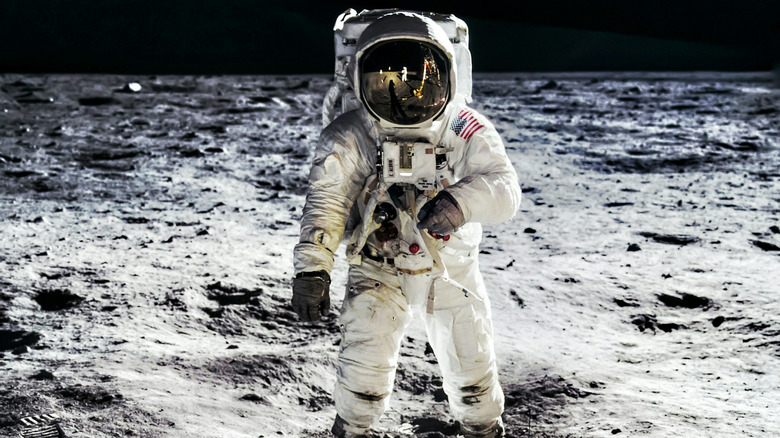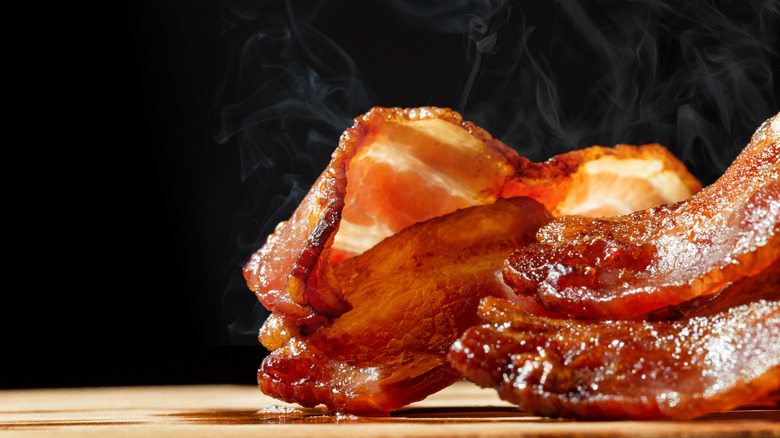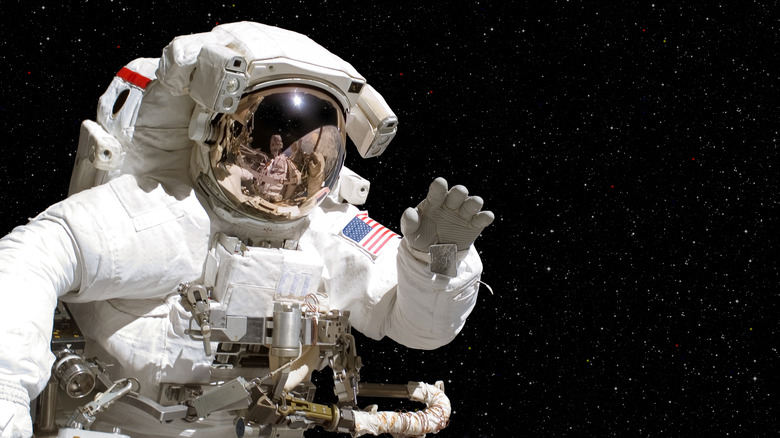Space Bacon, Anyone? How The Breakfast Staple Made It To The Moon
When Apollo 11 landed on the moon on July 20, 1969, it was a momentous occasion. Upwards of 650 million people around the world sat in stunned silence and anticipation as two American astronauts took their first steps on Earth's satellite planet. When Neil Armstrong and Buzz Aldrin went back to the lunar module after their initial exploration, it wouldn't have surprised anyone if they feasted on dehydrated surf and turf, with glasses of floating champagne in celebration, but it wasn't beef or lobster on their plates, it was bacon.
Any bacon lover would agree that the salty, crunchy, porky, fatty food is completely appropriate for celebratory occasions (or any occasion, really), but the pork product likely wasn't chosen to be part of the astronauts' meal plan because they requested it. Rather, it traveled well in space. Figuring out which foods could be transported into and consumed in low-gravity conditions was just one large piece of the space travel puzzle for NASA scientists to figure out before Apollo 11. Foods had to meet weight and volume limits, stay safe and edible without refrigeration, not be overly crumbly (fine crumbs could affect equipment), and offer enough calories and nutrition for the astronauts. Bacon checked all the boxes, as did peaches, strawberry cubes, and grape and orange drinks, which rounded out the meal Armstrong and Aldrin dined on after their moonwalk.
Space food had already come a long way
By the time of the Apollo missions, scientists and astronauts had already been testing edibles in space during the prior Mercury and Gemini missions. Fast-forward to the 1969 moon landing, and the food wasn't bad, by comparison. During the Project Mercury flights, much of the food astronauts ate came in paste form, in toothpaste-like tubes. In April 1961, Soviet pilot and cosmonaut Yuri Gagarin became the first human to fly to space, and he feasted on beef and liver paste in a tube. Yum. During the Gemini missions, cosmic culinary arts had improved, with an emphasis put on freeze-drying and dehydrating foods for space flights. The foods could be placed in packages in which water could be inserted for rehydration.
During the Apollo years, the foods' packaging was similar to those during Gemini, but the variety was greater. Foods in the pilots' meal plans included cornflakes, scrambled eggs, hot dogs, spaghetti, tuna salad, and peanut butter. Coffee was also placed on the menu — and if you ask me, what could be better than coffee and bacon, with a view of planet Earth to go with it?
Is bacon still on the microgravity menu?
During Apollo 13, astronaut Jim Lovell reportedly told mission control, "Happiness is bacon squares for breakfast." The appreciation for bacon is clearly out of this world, yet, someone, somewhere (likely a brainiac at NASA) decided bacon didn't need to be a food option for astronauts anymore. Although the food list has grown from fewer than 70 foods in the Apollo era to over 200 today, bacon is noticeably missing. The closest thing space travelers will find are sausage patties. Of course, one hardly becomes an astronaut for the food, and it's a good thing they don't have to squeeze meat paste from a tube anymore, but, seriously NASA, bacon can't take up that much room aboard, can it?
Things are a bit different at the International Space Station, which has refrigeration and freezing capabilities. Here, visitors will find bacon and a large variety of meals, fresh fruits, desserts, dairy items, and snacks.


